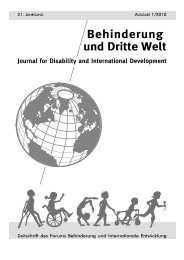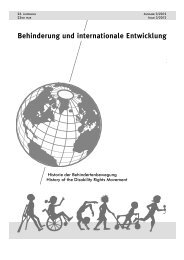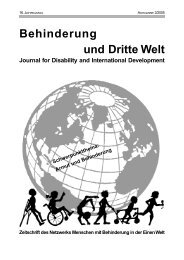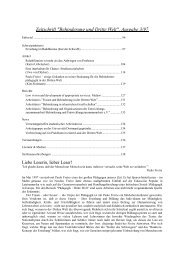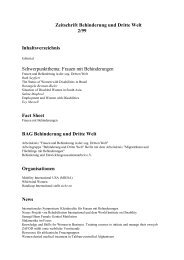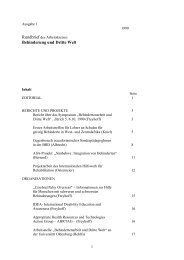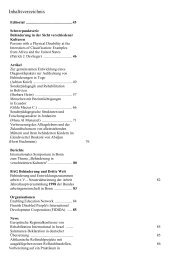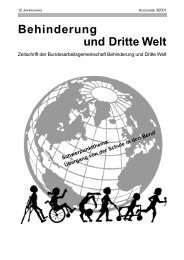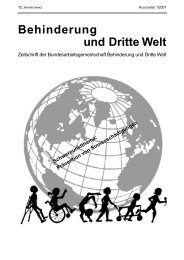Zeitschrift Behinderung und Dritte Welt
Zeitschrift Behinderung und Dritte Welt
Zeitschrift Behinderung und Dritte Welt
You also want an ePaper? Increase the reach of your titles
YUMPU automatically turns print PDFs into web optimized ePapers that Google loves.
S CHWERPUNKTTHEMAalso a case of a Dwarf couple, who once pregnant,wanted to abort a fetus that would grow to an averageheight rather than being a Dwarf (Discussed atDisabled Peoples International World Summit inSeoul, Korea in 2006). There was a huge outcryagainst the parents’ decision, unlike the public assentfor routine pre-natal tests that allow parents thechoice of aborting a fetus with a pre-disposition toDwarfism. This double standard illustrates theeugenic, ableist ideology of our contemporary society.6 The topic of HIV, Human Rights, and Women in thecontext of HIV Criminalization emerged several timesat the most recent International Conference on AIDSand STIs in Africa (ICASA) held in Dakar, Senegal inDecember 2008. A specific session discussed this atlength as well as exposing the links between thestruggles of people living with HIV/AIDS and criminalizationand people with disabilities and reproductiverights. This session was hosted by ARASA (AIDSand Rights Alliance for Southern Africa) on December4, 2008. Please see www.arasa.info for more details.7 The Nazi program of racial hygiene took eugenic philosophyto its logical conclusion, eliminating peoplejudged to be unfit or subnormal. People with disabilitieswere the first to be targeted as useless eaters. Atleast one h<strong>und</strong>red thousand people with disabilitiesand mental illnesses were murdered in gas chambers(Roeher Disability, Community and Society: Exploringthe Links. North York: L’Institut Roeher Institute 1996,7). The “philosophy, personnel, and equipment usedto kill people with disabilities” developed the processfor the extermination of Jews and other ethnic groups(21). Eugenic enthusiasts in Canada fell silent whenthe news became public that Nazi race improvementpractice shifted from sterilizing to killing the unfit(McLaren 147). See also Black, Edwin. War Againstthe Weak: Eugenics and America's Campaign to Createa Master Race. New York: Four Walls Eight Windows,2003. and Forgotten Crimes: The Holocaustand People with Disabilities. A Report by DisabilityRights Advocates. December 1999.8 This was discussed in ARASA’s session on HIV and HumanRights at ICASA 2008 (Dakar, Senegal).ReferencesNo author (1993): Childbirth support for women with disabilities:a report of the equity committee of the interimregulatory council on midwifery. Canadian women’sstudies. DownsviewBLACK, E. (2003): War Against the Weak: Eugenics andAmerica's Campaign to Create a Master Race. NewYorkBLACK, E. (1999): Forgotten Crimes: The Holocaust andPeople with Disabilities. BerkeleyENNS, R (1999). A voice unheard: the Latimer case andpeople with disabilities. HalifaxGROCE, N. (2005): HIV/AIDS and individuals with disability.Health and human rights. BostonLINTON, S. (1998): Claiming Disability: Knowledge andIdentity. New YorkLLOYD, M. (1992): Does she boil eggs? Towards a feministmodel of disability. Disability, handicap and society.LondonMCLAREN, A. (1990): Our own master race: eugenics inCanada, 1885-1945. TorontoNEATH, J. (1997): Social causes of impairment, disabilityand abuse: a feminist perspective. Journal of disabilitypolicy studies. AustinODELL, T. (1993): Disability and Relationships. CanadianWoman Studies. DownsviewREINIKAINEN, M. (2008): Disablistic practices of womanhood.NORA – Nordic journal of feminist and genderresearch. OsloTHOMSON, R.G. (2004): Integrating disability, transformingfeminist theory. Gendering disability. PiscatawaySHAKESPEARE, S. (2006): Disability rights and wrongs.OxonSOBSEY, D. (1994): Violence and abuse in the lives of peoplewith disabilities: The end of silet acceptance?BaltimoreSTEHLIK, D. (2001): A brave new world: neo-eugenicsand its challenge to difference. Violence against women.DaytonUNITED NATIONS (2003): United nations enable website.International norms and standards relating to disability,rights of women with disabilities.www.un.org/esa/socdev/enable/comp504.htmYOUNG, I.M. (1990): Justice and politics of difference.PrincetonWENDELL, S. (1989): Toward a feminist theory of disability.Hypatia. BaltimoreWINTERSON, J. (2002): How would we feel if blind womenclaimed the right to a blind baby? The Guardian.LondonZusammenfassung: Dieser Artikel argumentiert, dass eineEinbindung des Themas Frauen <strong>und</strong> <strong>Behinderung</strong> in dieFrauenbewegung den Kampf von Frauen mit <strong>Behinderung</strong>gegen HIV/AIDS stärken kann, indem man die tiefsitzendenVorurteile erforscht, die in Bezug auf die Sexualität vonFrauen mit <strong>Behinderung</strong> bestehen <strong>und</strong> wie sie die Wirkungvon HIV/AIDS auf Frauen mit <strong>Behinderung</strong> verschärfen. Ererörtert, wie die Frauenbewegung in der Geschichte dieVorurteile gegenüber Frauen mit <strong>Behinderung</strong> verstärkt hat,aber auch die heute wachsenden Möglichkeiten, zusammenzu arbeiten. Er basiert auf einer Überprüfung einerbeschränkten Auswahl von Studien über Frauen mit <strong>Behinderung</strong>genauso wie auf persönlicher Erfahrung <strong>und</strong> Forschungder Autorinnen.Résumé: Cet article présente la thèse que l’intégration duthème Femmes et Handicap dans le mouvement féministepeut renforcer le combat que mènent les femmes handicapéescontre le HIV/SIDA en explorant les idées reçues concernantla sexualité des femmes handicapées et commentelles exacerbent les effets du VIH/SIDA sur les femmes han-20 <strong>Zeitschrift</strong> <strong>Behinderung</strong> <strong>und</strong> <strong>Dritte</strong> <strong>Welt</strong> 3/2009



